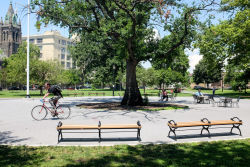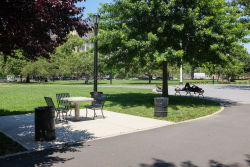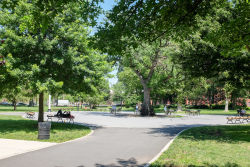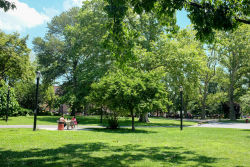Coffey Park
Coffey Park
Coffey Park, like nearby Coffey Street, is named for Michael J. Coffey (1839-1907), the former state senator, alderman, and district leader representing Red Hook. Coffey was born in 1839 in County Cork, Ireland, and then immigrated to the United States with his parents at the age of five. He went to school in Red Hook and soon began working in the Brooklyn Navy Yard. When the Civil War began, Coffey joined the United States Navy. He served on the gunboat Monticello, and quickly earned the respect of his commanding officer. At the conclusion of the war, Coffey returned to Red Hook and became the Democratic district leader for Red Hook Point. The Red Hook district was locally known as “Coffeyville” by the end of his 39-year tenure as district leader.
Coffey was elected to the City Board of Aldermen (predecessor of the City Council) in 1867 and the New York State Assembly in 1874. Partition Street was renamed Coffey Street on November 30, 1891, and in 1892 Coffey was re-elected as an Alderman. Coffey was chosen as president of the Board of Aldermen, and served in that post until he was elected to the New York State Senate in 1893. Coffey remained there until 1901, when he upset the nomination of John M. Gray for Register of Kings County. In an attempt to remove him from power, the Executive Committee of the Kings County Democratic General Committee charged him with treason. Coffey successfully fought his case before the Court of Appeals, before going on to persue a brief career constructing docks. Coffey died after surgical complications at Long Island College Hospital on March 22, 1907.
Colonized by the Dutch in 1636, Red Hook, or “Roode Hoek” as it was once known, takes its name from the color of its soil and the shape of its shoreline. After the marshy land had remained mostly rural for two centuries, in the 1840s Red Hook began to draw more residents, following the opening of the Atlantic Basin. The area’s docks and wharves helped the peninsula grow into a thriving shipping center and a particularly strategic port during the Civil War. The former stomping grounds of gangster Al Capone, Red Hook is now a community that includes residents from many parts of the world. The Red Hook Houses, one the City’s first public housing initiatives (built for dock-workers’ families in the 1930s), today houses over 7,000 residents.
The land for Coffey Park was acquired in three parcels. The Brooklyn Parks Department purchased a 5.284-acre tract on November 18, 1892, and the park opened in 1901. The City purchased a second 2.298-acre parcel on September 20, 1907. Finally on June 11, 1943, the City acquired a 0.689-acre parcel on Pioneer Street between Richards Street and Dwight Street by local law and turned it over to Parks. A renovation of Coffey Park was completed on July 7, 1999 with $840,000 provided by Council Member Angel Rodriguez, $24,000 provided by Mayor Giuliani, and $1,055,000 provided by Borough President Howard Golden. Coffey Park has a spray shower, play equipment with safety surfacing, swings for children, benches, game tables, picnic tables, basketball courts, handball courts, an asphalt baseball diamond with a backstop, two flagpoles with yardarms, hippopotamus animal art, and crocodile-shaped benches.
Check out your park's Vital Signs
Clean & Safe
Green & Resilient
Empowered & Engaged Users
Share your feedback or learn more about how this park is part of a
Vital Park System







